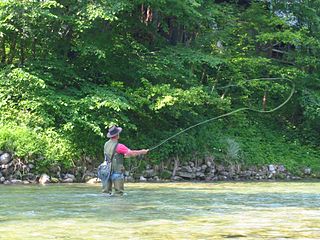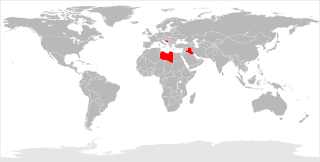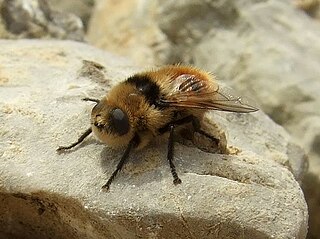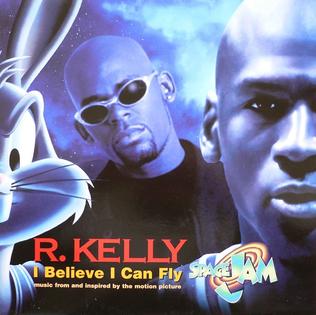
Fly-by-wire (FBW) is a system that replaces the conventional manual flight controls of an aircraft with an electronic interface. The movements of flight controls are converted to electronic signals transmitted by wires, and flight control computers determine how to move the actuators at each control surface to provide the ordered response. It can use mechanical flight control backup systems or use fully fly-by-wire controls.

Amanita muscaria, commonly known as the fly agaric or fly amanita, is a basidiomycete of the genus Amanita. It is also a muscimol mushroom. Native throughout the temperate and boreal regions of the Northern Hemisphere, Amanita muscaria has been unintentionally introduced to many countries in the Southern Hemisphere, generally as a symbiont with pine and birch plantations, and is now a true cosmopolitan species. It associates with various deciduous and coniferous trees.

Flies are insects of the order Diptera, the name being derived from the Greek δι- di- "two", and πτερόν pteron "wing". Insects of this order use only a single pair of wings to fly, the hindwings having evolved into advanced mechanosensory organs known as halteres, which act as high-speed sensors of rotational movement and allow dipterans to perform advanced aerobatics. Diptera is a large order containing an estimated 1,000,000 species including horse-flies, crane flies, hoverflies and others, although only about 125,000 species have been described.

Hover flies, also called flower flies or syrphid flies, make up the insect family Syrphidae. As their common name suggests, they are often seen hovering or nectaring at flowers; the adults of many species feed mainly on nectar and pollen, while the larvae (maggots) eat a wide range of foods. In some species, the larvae are saprotrophs, eating decaying plant and animal matter in the soil or in ponds and streams. In other species, the larvae are insectivores and prey on aphids, thrips, and other plant-sucking insects.

Fly fishing is an angling method that uses a light-weight lure—called an artificial fly—to catch fish. The fly is cast using a fly rod, reel, and specialized weighted line. The light weight requires casting techniques significantly different from other forms of casting. The flies may resemble natural invertebrates, bait-fish, or other food organisms.

A no-fly zone, also known as a no-flight zone (NFZ), or air exclusion zone (AEZ), is a territory or area established by a military power over which certain aircraft are not permitted to fly. Such zones are usually set up in an enemy power's territory during a conflict, similar in concept to an aerial demilitarized zone, and usually intend to prohibit the enemy's military aircraft from operating in the region. Military action is employed by the enforcing state and, depending on the terms of the NFZ, may include preemptive attacks to prevent potential violations, reactive force targeted at violating aircraft, or surveillance with no use of force. Air exclusion zones and anti-aircraft defences are sometimes set up in a civilian context, for example to protect sensitive locations, or events such as the 2012 London Olympic Games, against terrorist air attack.

The Fly is a 1986 American science fiction-horror film directed and co-written by David Cronenberg. Produced by Brooksfilms and distributed by 20th Century Fox, the film stars Jeff Goldblum, Geena Davis and John Getz. Loosely based on George Langelaan's 1957 short story of the same name and the 1958 film of the same name, The Fly tells of an eccentric scientist who, after one of his experiments goes wrong, slowly turns into a fly-hybrid creature. The score was composed by Howard Shore and the make-up effects were created by Chris Walas, along with makeup artist Stephan Dupuis.

McFly are an English pop band formed in London in 2003. The band took their name from the Back to the Future character Marty McFly. The band consists of Tom Fletcher, Danny Jones, Dougie Poynter and Harry Judd (drums). They were signed to Island Records from their 2004 launch until December 2007, before creating their own label, Super Records.

"Fly Me to the Moon", originally titled "In Other Words", is a song written in 1954 by Bart Howard. Kaye Ballard made the first recording of the song the year it was written. Frank Sinatra's 1964 version was closely associated with the Apollo missions to the Moon.

The infield fly rule is a rule of baseball and softball that treats certain fly balls as though caught, before the ball is caught, even if the infielder fails to catch it or drops it on purpose. The umpire's declaration of an infield fly means that the batter is out regardless of whether the ball is caught. The rule exists solely to prevent the defense from executing a double play or triple play by deliberately failing to catch a ball that an infielder could catch with ordinary effort.

Botflies, also known as warble flies, heel flies, and gadflies, are a family of flies technically known as the Oestridae. Their larvae are internal parasites of mammals, some species growing in the host's flesh and others within the gut. Dermatobia hominis is the only species of botfly known to parasitize humans routinely, though other species of flies cause myiasis in humans.

Recreational fishing, also called sport fishing or game fishing, is fishing for leisure, exercise or competition. It can be contrasted with commercial fishing, which is professional fishing for profit; or subsistence fishing, which is fishing for survival and livelihood.

In the game of rugby union, there are 15 players on each team, comprising eight forwards and seven backs. In addition, there may be up to eight replacement players "on the bench", numbered 16–23. Players are not restricted to a single position, although they generally specialise in just one or two that suit their skills and body types. Players that play multiple positions are called "utility players".

In the sports of baseball and softball, a batted ball is a pitch that has been contacted by the batter's bat. Depending on where the ball lands, a batted ball can become either a fair ball or a foul ball. If a batted ball is a fair ball, fielders attempt to get the batter out. A foul ball is assessed as a strike unless the batter has already accumulated two strikes, in which case the number of strikes does not increase. Batted balls are also classified by their trajectory. The most common of these trajectory-based classifications are fly balls, line drives, and ground balls.

Bromo-DragonFLY is a substance related to the phenethylamine family. Bromo-DragonFLY is considered a potent hallucinogen, having around one third the potency of LSD with a normal dose in the region of 200 μg to 800 μg, and it has an extremely long duration of action, up to several days. Bromo-DragonFLY has a stereocenter and (R)-(−)-bromo-DragonFLY is the more active stereoisomer.

Fly ash, flue ash, coal ash, or pulverised fuel ash – plurale tantum: coal combustion residuals (CCRs) – is a coal combustion product that is composed of the particulates that are driven out of coal-fired boilers together with the flue gases. Ash that falls to the bottom of the boiler's combustion chamber is called bottom ash. In modern coal-fired power plants, fly ash is generally captured by electrostatic precipitators or other particle filtration equipment before the flue gases reach the chimneys. Together with bottom ash removed from the bottom of the boiler, it is known as coal ash.

"I Believe I Can Fly" is a 1996 song written and performed by American singer R. Kelly, from the soundtrack to the 1996 film Space Jam. It was originally released on November 26, 1996, and was later included on Kelly's 1998 album R.

2C-B-FLY is a psychedelic phenethylamine of the 2C family. It was first synthesized in 1996 by Aaron P. Monte.

An artificial fly or fly lure is a type of fishing lure, usually used in the sport of fly fishing. In general, artificial flies are an imitation of aquatic insects that are natural food of the target fish species the fly fishers try to catch. Artificial flies are constructed by fly tying, in which furs, feathers, thread or any of very many other materials are tied onto a fish hook.

The housefly is a fly of the suborder Cyclorrhapha. It is believed to have evolved in the Cenozoic Era, possibly in the Middle East, and has spread all over the world as a commensal of humans. It is the most common fly species found in houses. Adults are gray to black, with four dark, longitudinal lines on the thorax, slightly hairy bodies, and a single pair of membranous wings. They have red eyes, set farther apart in the slightly larger female.



















